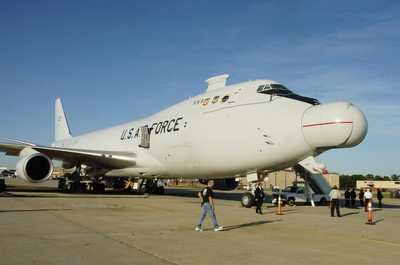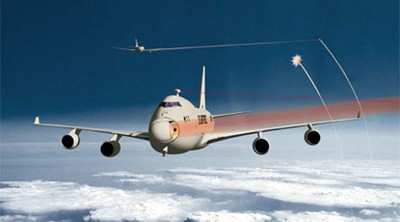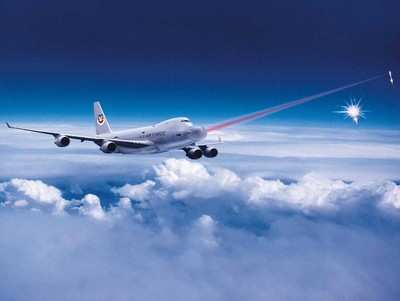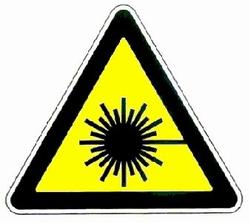Modified 747 Designed To Use Light Beam To Shoot Down
Missiles
A typical-looking 747 aircraft on the tarmac this week at
Maryland's Andrews Air Force Base -- distinguishable from other
747s only by its glass, bulb-shaped nose -- could one day be the
silver bullet that shoots ballistic missiles out of the sky.

But what's revolutionary about the prototype Airborne Laser
aircraft, which arrived last night after its first nonstop
cross-country flight, is that it won't use bullets to take out its
target, explained Air Force Col. John Daniels, program
director.
It will use light.
"What makes this revolutionary is that you can engage targets at
the speed of light -- 186,000 miles per second," Daniels said. "So
we can go from New York to Los Angeles before you can blink your
eye. Think about that. You can't blink your eye faster than this
weapon system or a beam of light goes across the country."
The Airborne Laser is being developed as an integral part of the
ballistic missile defense system to protect the United States, its
allies and its deployed troops against a ballistic missile attack,
he explained. An advanced detection-and-tracking system,
state-of-the-art optics and a high-energy laser would detect a
missile launch and track it during the boost phase.

The world's largest turret assembly, encased in the
glass-enclosed aircraft nose, would track the missile and determine
a precise aim point. A laser would measure disturbances in the
atmosphere and adjust the on-board optics to account for them.
Another laser would fire a beam -- technically, a
"megawatt-class chemical oxygen iodine laser beam" -- to zap the
missile until it breaks apart.
As futuristic as this concept sounds, the Airborne Laser project
is moving steadily forward. Flight tests on the Airborne Laser are
slated to wrap up this summer at California's Edwards Air Force
Base.
The chemical laser has had more than 70 successful firings over
the past three years, and will be installed aboard the aircraft
starting later this year in preparation for the first shootdown of
a ballistic missile target, scheduled in mid-2009.
"We are going to put that big laser in the back ... and then
we're ready to shoot a missile down," Daniels said. "So it's a
pretty exciting time to be on the program. The biggest challenge we
have right now is integration. The optics system is working. The
battle management system works well. We even tracked an
(intercontinental ballistic missile) with the sensors on the
airplane. ... The laser works well on the ground."

Putting all that capability together and having it operate
effectively is a much more significant step, he said.
"When you put those big pieces together, and you get the
software talking to each other and the systems, that's not trivial.
It's really an integration challenge," he said. "No miracles are
needed, but the integration step is not easy."
 Lessons learned from this
initial prototype, with the tail number "0001," will be
incorporated into a "production representative" model that is
easier to operate and maintain and less expensive to build, he
said. "That's the whole purpose of this plane, to give us those
lessons learned so we know what to do different on the second
airplane."
Lessons learned from this
initial prototype, with the tail number "0001," will be
incorporated into a "production representative" model that is
easier to operate and maintain and less expensive to build, he
said. "That's the whole purpose of this plane, to give us those
lessons learned so we know what to do different on the second
airplane."
Ultimately, the Air Force hopes to have seven Airborne Laser
aircraft. Plans call for them to be based in the United States, at
a base with a long runway and the infrastructure needed to support
large aircraft, Daniels said.
"But they would be forward-operated, depending upon the threat,"
Daniels aid. "If you had threats in multiple parts of the world, it
is probably commonsensical that a commander may decide to send a
few planes one place and a few planes somewhere else."
Aircraft would take off loaded with enough chemicals that, with
aerial refueling, could get where they needed to be quickly and be
able to operate for as long as possible. A single chemical load
would be able to destroy "many, many missiles," Daniels said.
The Missile Defense Agency manages the Airborne Laser program,
which is based at Kirtland Air Force Base in Albuquerque, NM.
The Airborne Laser is slated to return tonight to Edwards for
more testing.
(Aero-News thanks Donna Miles, American Forces Press
Service)
 USCG MH-60 To The Rescue (Again) -- Rescues 4 Boaters
USCG MH-60 To The Rescue (Again) -- Rescues 4 Boaters Gray Eagle Order Placed for Army National Guard
Gray Eagle Order Placed for Army National Guard Aero-Biz Survival 101 (1120a): Expert Ideas To Help You Through Tough Times
Aero-Biz Survival 101 (1120a): Expert Ideas To Help You Through Tough Times Airborne 06.03.24: Rotax 915/916 SB, Starship 4 Ready?, B-17 Mementos
Airborne 06.03.24: Rotax 915/916 SB, Starship 4 Ready?, B-17 Mementos Mid-Continent Instruments and Avionics Mourns Former Leader
Mid-Continent Instruments and Avionics Mourns Former Leader






